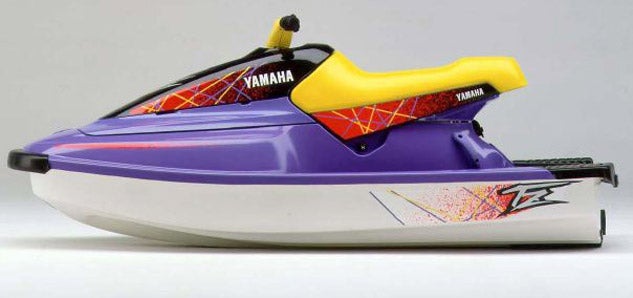Remembering the Yamaha WaveBlaster
The PWC that brought motorcycle-like handling to the industry
A number of personal watercraft have left a lasting mark over the years, but it’s a fair bet the Yamaha WaveBlaster resides amongst the very best. Introduced in 1993, this eight-foot long, three-foot wide craft was the first to truly bring the look and feel of a motorcycle to the personal watercraft market.
Riders could carve exceptionally aggressive turns with a long-awaited inside lean, darting in and out of corners with agility previously unseen in the industry. Power, for the time, was spirited, produced by Yamaha’s infamous 701cc two-stroke engine. The ‘Blaster quickly won Watercraft of the Year status from industry publications, which noted the craft had truly created a new category in the market.
A great deal of the WaveBlaster’s success was thanks to its hull design. A closer relation to Yamaha’s SuperJet standup than the typical V-hull sit-down runabout, it featured concave pockets near the bow that created suction, planting the hull in those corners. Strakes further glued the hull to the water. That intuitive lean, however, was primarily the result of soft chines, a trait that defines many of today’s lean-in rides. The design allowed the hull to easily roll into the turns, and riders loved the craft for it.
COMPARISON: Read our review of the 2015 Yamaha SuperJet
They also loved the Yamaha 701cc engine. A workhorse that would power many Yamaha models over time, it was rated at only 63 hp initially but, then again, the ‘Blaster weighed a mere 320 pounds. The result was a 44 mph top speed, a figure that crept to 45 mph when a dual-carb version was introduced in 1996.
Apart from performance and handling, WaveBlasters mostly followed the KISS principle. Controls were simple, with just a low-slung handlebar and trigger throttle. The seat was elevated off the deck and suspended over the craft’s aft quarters. The boat wasn’t always the greatest in a straight line, but that wasn’t a goal. This was a model designed to turn, and offer up a tremendous amount of fun in the process.
So why did such a lauded craft enjoy only a four-year lifespan? Perhaps the boat’s most glaring drawback was that its high center of gravity made it a challenge to board, and especially re-board in deep water. WaveBlasters were also tippy at idle speeds and, perhaps most damning in a broad retail market, required a certain amount of balance and athletic skill to be enjoyed to the fullest. But for those that fit the profile the craft was a runaway favorite. Though Yamaha discontinued the craft after 1996, ‘Blasters continue to have a strong following, especially for those who like to occasionally venture into ocean waves.

Longtime PWC enthusiast Patrick Butler has owned nine of the models over the years. A native of Lake Placid, NY, he currently counts an original 1993, as well as two 1994s built for surf riding and wave jumping among his collection.
COMPARISON: Read our review of the 2004 Kawasaki Jet Ski 900 STX
“WaveBlasters are very unique and the most fun ride on the water,” contends Butler. “Anyone can ride one, from newbies to veterans, and they are a blast literally in all water conditions. If you get tired and want to stop and rest you can just sit on the seat. Although when you are ready to rip in stock form, or better slightly modified, you are ready to really blast.”

For those who want to take a crack at this cherished old-school ride, you can still find WaveBlasters on the used market in the range of $900-$1500. Butler suggests spending another $1500 on parts (his favorites include an aftermarket cylinder head, FactoryPipe exhaust, Ocean Pro ride plate, Jet dynamics scoop grate, TBM Racing trigger throttle and ODI grips) to produce a truly exceptional ride.
“There is nothing like the ‘Blaster. It truly handles like a dirt bike on the water. You can be having the time of your life for $3,000-$4,500,” says Butler. “I love ‘Blasters! If Yamaha would put a four-stroke in the old hull, that’s all I would ever need!”

Get PersonalWatercraft.com in your Inbox!
Like PersonalWatercraft.com on Facebook
Comments
Most Popular

2025 Yamaha JetBlaster PRO 2-Up Review

Remembering the Sea-Doo XP

2024 Kawasaki Jet Ski STX 160X Review

Whatever Happened to the Wetbike?

2025 Yamaha JetBlaster Review














 Your Privacy Choices
Your Privacy Choices